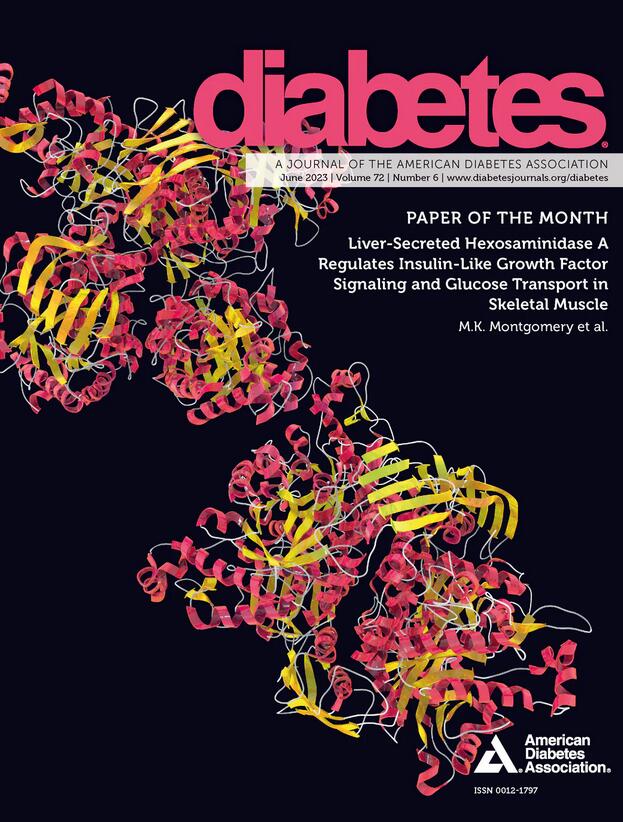74-OR: ADA Presidents' Select Abstract: CGM Metrics from Five Studies Identify Participants at High Risk of Imminent Type 1 Diabetes (T1D) Development
IF 6.2
1区 医学
Q1 ENDOCRINOLOGY & METABOLISM
引用次数: 0
Abstract
Introduction & Objective: We assessed if continuous glucose monitoring (CGM) metrics accurately identify imminent stage 3 T1D diagnosis in those with islet autoantibody (IAb) positivity. Methods: Baseline CGM data were collected from participants with ≥1 positive IAb type from five studies: ASK (N=79), BDR (N=22), DAISY (N=18), DIPP (N=8), and TrialNet (N=91). Median follow-up time was 2.6 y (IQR: 1.5 to 3.6 y). A CGM and baseline factor model and a baseline-only model were compared. CGM model classified participants as low (N=97), medium (N=74), or high (N=47) risk of stage 3 T1D based on <10%, 10-<30%, and ≥30% probability by year 2. Results: CGM model found % time >140 mg/dL (TA140), area under the curve 140 mg/dL (AUC140), glucose SD, sex, first degree relative, IA2A, and GADA status were more predictive of T1D progression compared to the baseline-only model (C-statistic: 0.76 vs. 0.62). The probability of developing T1D by 2 years was 4%, 17%, and 51% in the low, medium, and high risk groups (Figure). Compared to low risk participants, high risk participants had higher TA140 (median: 10% vs 2%), AUC140 (mean: 2.9 vs. 1.1 mg/dL), and glucose SD (mean: 24 vs. 18 mg/dL). Conclusion: CGM metrics can help predict T1D progression and classify participant’s risk of impending T1D diagnosis. CGM can be used to better monitor the risk of T1D progression and define eligibility for potential prevention trials. Disclosure P. Calhoun: None. C. Spanbauer: None. A. Steck: None. B.I. Frohnert: None. M.A. Herman: Research Support; Eli Lilly and Company. B. Keymeulen: None. R. Veijola: Advisory Panel; Sanofi. J. Toppari: None. A. Desouter: None. F.K. Gorus: None. M.A. Atkinson: None. D.M. Wilson: Advisory Panel; Enable Biosciences, Inc. S. Pietropaolo: None. R. Beck: Consultant; Insulet Corporation. Research Support; Insulet Corporation. Consultant; Tandem Diabetes Care, Inc. Research Support; Tandem Diabetes Care, Inc. Consultant; Beta Bionics, Inc. Research Support; Beta Bionics, Inc., Dexcom, Inc., Bigfoot Biomedical, Inc. Consultant; Novo Nordisk. Research Support; Novo Nordisk, Eli Lilly and Company. Consultant; embecta, Vertex Pharmaceuticals Incorporated, Hagar, Ypsomed AG, Sanofi, Zucara Therapeutics, Sequel. Funding JDRF74-OR: 美国糖尿病协会主席精选摘要:从五项研究中得出的 CGM 指标可识别出 1 型糖尿病 (T1D) 发病风险高的参与者
引言& 目的:我们评估了连续血糖监测(CGM)指标是否能准确识别胰岛自身抗体(IAb)阳性者中即将被诊断为T1D 3期的患者。方法:从五项研究中收集≥1种IAb阳性参与者的基线CGM数据:ASK(79 人)、BDR(22 人)、DAISY(18 人)、DIPP(8 人)和 TrialNet(91 人)。随访时间中位数为 2.6 年(IQR:1.5 至 3.6 年)。CGM和基线因素模型与纯基线模型进行了比较。CGM 模型根据第 2 年出现 T1D 3 期的概率<10%、10-<30% 和≥30% 将参与者分为低(97 人)、中(74 人)或高(47 人)风险。结果:CGM模型发现,与纯基线模型相比,%时间>140 mg/dL (TA140)、曲线下面积140 mg/dL (AUC140)、血糖SD、性别、一级亲属、IA2A和GADA状态更能预测T1D进展(C统计量:0.76 vs. 0.62)。在低、中、高风险组中,2 年后患 T1D 的概率分别为 4%、17% 和 51%(图)。与低风险参与者相比,高风险参与者的 TA140(中位数:10% vs. 2%)、AUC140(平均值:2.9 vs. 1.1 mg/dL)和血糖 SD(平均值:24 vs. 18 mg/dL)更高。结论CGM 指标有助于预测 T1D 的进展,并对参与者即将被诊断为 T1D 的风险进行分类。CGM 可用于更好地监测 T1D 进展风险,并确定潜在预防试验的资格。披露 P. Calhoun:无。C. Spanbauer: 无。A. Steck:无:无。B.I. Frohnert:无。M.A. Herman:研究支持;礼来公司。B. Keymeulen: None.R. Veijola:赛诺菲顾问团。J. Toppari: None.A. Desouter:无。F.K. Gorus:无。M.A. Atkinson: None.D.M. Wilson:顾问团;Enable Biosciences, Inc.S. Pietropaolo:无。R. Beck:顾问;Insulet 公司。研究支持;Insulet 公司。顾问;Tandem Diabetes Care, Inc.研究支持;Tandem Diabetes Care, Inc.顾问;Beta Bionics, Inc.研究支持;Beta Bionics, Inc.、Dexcom, Inc.、Bigfoot Biomedical, Inc.顾问;诺和诺德公司。研究支持;诺和诺德、礼来公司。顾问;embecta、Vertex Pharmaceuticals Incorporated、Hagar、Ypsomed AG、赛诺菲、Zucara Therapeutics、Sequel。资助 JDRF
本文章由计算机程序翻译,如有差异,请以英文原文为准。
求助全文
约1分钟内获得全文
求助全文
来源期刊

Diabetes
医学-内分泌学与代谢
CiteScore
12.50
自引率
2.60%
发文量
1968
审稿时长
1 months
期刊介绍:
Diabetes is a scientific journal that publishes original research exploring the physiological and pathophysiological aspects of diabetes mellitus. We encourage submissions of manuscripts pertaining to laboratory, animal, or human research, covering a wide range of topics. Our primary focus is on investigative reports investigating various aspects such as the development and progression of diabetes, along with its associated complications. We also welcome studies delving into normal and pathological pancreatic islet function and intermediary metabolism, as well as exploring the mechanisms of drug and hormone action from a pharmacological perspective. Additionally, we encourage submissions that delve into the biochemical and molecular aspects of both normal and abnormal biological processes.
However, it is important to note that we do not publish studies relating to diabetes education or the application of accepted therapeutic and diagnostic approaches to patients with diabetes mellitus. Our aim is to provide a platform for research that contributes to advancing our understanding of the underlying mechanisms and processes of diabetes.
 求助内容:
求助内容: 应助结果提醒方式:
应助结果提醒方式:


